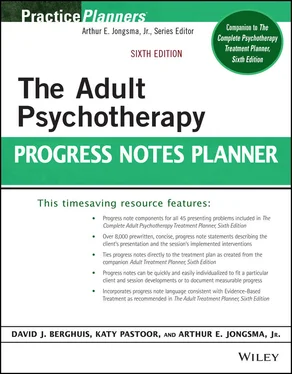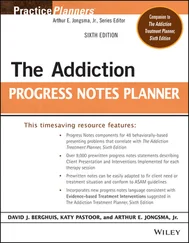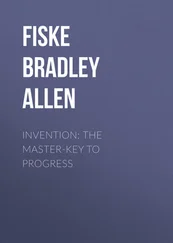36 Discuss Management of Lapse Risk Situations (36)The client was assisted in identifying future situations or circumstances in which lapses could occur.The session focused on rehearsing the management of future situations or circum- stances in which lapses could occur.The client was reinforced for his/her/their appropriate use of lapse management skills.The client was redirected in regard to his/her/their poor use of lapse management skills.
37 Encourage Routine Use of Strategies (37)The client was instructed to routinely use the strategies that he/she/they have learned in therapy (e.g. cognitive restructuring, exposure).The client was urged to find ways to build his/her/their new strategies into his/her/their life as much as possible.The client was reinforced as he/she/they reported ways in which he/she/they have incorporated coping strategies into his/her/their life and routine.The client was redirected about ways to incorporate his/her/their new strategies into his/her/their routine and life.
38 Develop a “Coping Card” (38)The client was provided with a “coping card” on which specific coping strategies were listed.The client was assisted in developing his/her/their “coping card” in order to list his/her/their helpful coping strategies.The client was encouraged to use his/her/their “coping card” when struggling with anxiety-producing situations.
39 Schedule a “Maintenance” Session (39)The client was scheduled for a “maintenance” session between 1 and 3 months after therapy ends.The client was advised to contact the therapist if he/she/they need to be seen prior to the “maintenance” session.The client's “maintenance” session was held and he/she/they were reinforced for his/her/their successful implementation of therapy techniques.The client's “maintenance” session was held and he/she/they were coordinated for further treatment, as his/her/their progress has not been sustained.
40 Use Motivational Interviewing (40)Techniques from motivational interviewing were used to help the client discuss ambivalence about changing current worry patterns.The client was assisted in deciding on whether to make changes.The client was assisted in identifying willingness to take action steps toward change.
41 Utilize Paradoxical Intervention (41)A paradoxical intervention was developed with the client in which he/she/they were encouraged to experience the anxiety at specific intervals each day for a defined length of time.The client has implemented the assigned paradoxical intervention and reported that it was difficult for him/her/them to maintain the anxiety as he/she/they were eager to get on with other activities.The client has experienced, in general, a reduction of his/her/their anxiety as he/she/they have developed an insight into his/her/their ability to control it; this insight was processed.The client has not used the paradoxical intervention and was redirected to do so.
42 Assign Cost-Benefit Analysis (42)The client was asked to complete a cost-benefit analysis as found in Ten Days to Self-Esteem! (Burns) in which he/she/they were asked to list the advantages and disadvantages of maintaining the anxiety.Completing the cost-benefit analysis exercise has been noted to be beneficial to the client as he/she/they developed more insight into the impact of anxiety on his/her/their daily life.The client has not followed through on completing the cost-benefit analysis of his/her/their anxiety and was encouraged to do so.
43 Identify Unresolved Conflicts (43)The client was assisted in becoming aware of unresolved life conflicts that contribute to his/her/their persistent fears.The client was assisted in clarifying his/her/their feelings of anxiety as they relate to unresolved life conflicts.The client was assisted in identifying steps that could be taken to begin resolving issues in his/her/their life that contribute to persistent fear and worry.As the client has been helped to resolve life conflicts, his/her/their feelings of anxiety have diminished.The client did not display insight into unresolved conflicts and how they contribute to his/her/their persistent fears and was gently offered examples in this area.
44 Develop Insight into Past Traumas (44)The client's past traumatic experiences that have become triggers for anxiety were examined.The client has been assisted in developing insight into how past traumatic experiences have led to anxiety in present unrelated circumstances.The client's insights into the role of past emotional pain and present anxiety were reinforced.The development of insight regarding past traumas has resulted in a reduction in the experience of anxiety.
45 List Life Conflicts (45)The client was asked to list his/her/their important past and present life conflicts that may contribute to his/her/their feelings of worry.The client's list of life conflicts that trigger anxiety was processed.The client was assisted in clarifying the causes for his/her/their worry and to put them into better perspective.The client was unable to make a connection between life conflicts and his/her/their anxiety/worry and was gently offered examples in this area, as well as ways to put them in better perspective.
46 Reinforce Responsibility Acceptance (46)The client was supported and reinforced for following through with the work, family, and social responsibilities rather than using escape and avoidance to focus on anxiety symptoms.The client reported performing responsibilities more consistently and being less preoccupied with the worry symptoms or fear that worry symptoms might occur; his/her/their progress was highlighted.
47 Teach Sleep Hygiene (47)The client was taught about sleep hygiene practices to help reestablish a consistent sleep-wake cycle.The client was taught to implement sleep hygiene practices.The client's use of sleep hygiene practices was reviewed, reinforcing for success and providing corrective feedback toward improvement.
1 1The numbers in parentheses correlate to the number of the Behavioral Definition statement in the companion chapter with the same title in The Complete Adult Psychotherapy Treatment Planner, Sixth Edition, by Jongsma, Peterson, and Bruce (Hoboken, NJ: Wiley, 2020).
2 2The numbers in parentheses correlate to the number of the Therapeutic Intervention statement in the companion chapter with the same title in The Complete Adult Psychotherapy Treatment Planner, Sixth Edition, by Jongsma, Peterson, and Bruce (Hoboken, NJ: Wiley, 2020).
ATTENTION DEFICIT DISORDER (ADHD)—ADULT
CLIENT PRESENTATION
1 ADHD Childhood History (1) 1 The client confirmed that his/her/their childhood history consisted of the following symptoms: behavioral problems at school, impulsivity, temper outbursts, and lack of concentration.The client had a diagnosed ADHD condition in his/her/their childhood.Although the client's symptoms were not diagnosed as ADHD, it can be concluded from the childhood symptoms that the ADHD condition was present at that time.
2 Lack of Attention to Detail (2)The client reported failure to give close attention to detail or making mistakes with things of low interest, even though they may be important to his/her/their life.The client's lack of ability to give close attention has resulted in his/her/their missing out on the comprehension of important details.The client's ability to give close attention seems to be increasing as he/she/they reported increased attention skills.
3 Fidgety (3)The client reported that he/she/they cannot sit still for any length of time, but often feel restless and fidgety.The client gave evidence of being restless and fidgety within the session, often moving about in his/her/their chair.The client's ability to rest comfortably for a longer period of time has increased.
4 Difficulty Sustaining Attention (4)The client reported that he/she/they have difficulty sustaining attention to tasks or activities.The client gave evidence of difficulty sustaining attention within today's session.The client's difficulty sustaining attention is diminishing and his/her/their focused concentration is increasing.
Читать дальше












